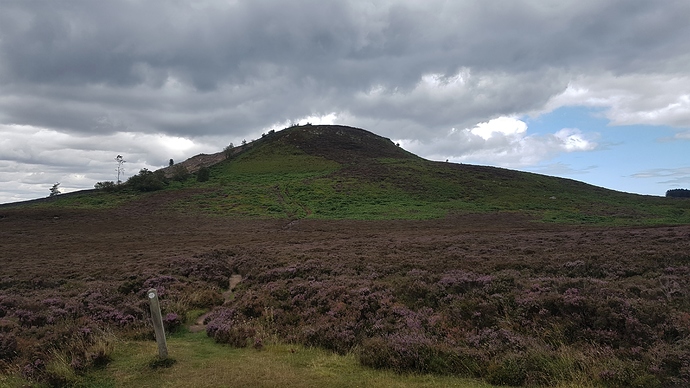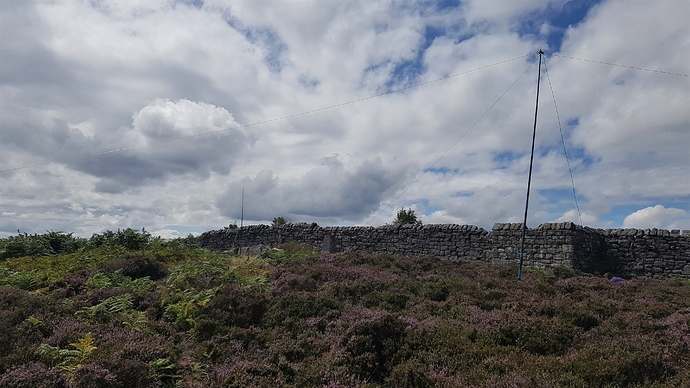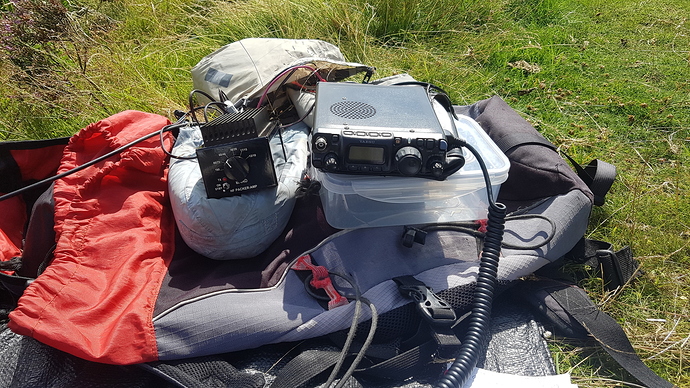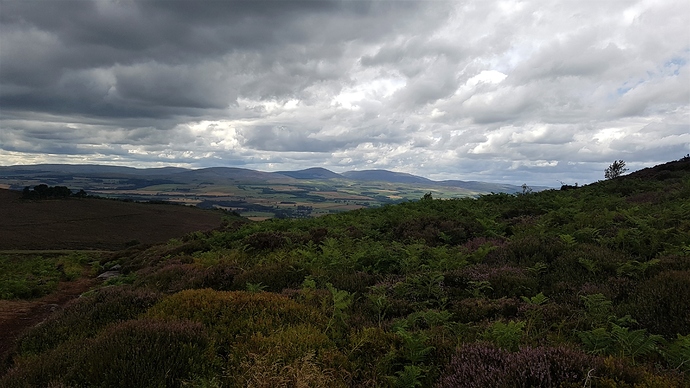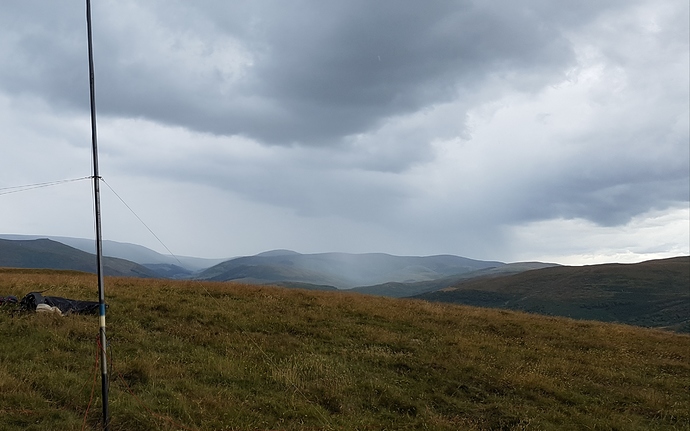As I write this report Europe and most of the United Kingdom has been basking in a glorious summer, or should that be baking in an uncomfortable manner?
Helen and I had run out of hills that are within an easy day trip quite a while ago so expeditions to far flung places, or even close by places, are eagerly anticipated. We pour over maps, read accounts of past activations and plan routes. We had a few days between two big weekend Geocaching Mega events that were in the North Yorkshire area and reasoned that it’s not that far from the Scottish border SOTA region, a region that I had previously chased all the summits.
The campsite base was in Bellingham, a lovely remote village with a Co-op, a couple of pubs and a couple of restaurants. Not that close to the planned hills but within an hour or so via long, straight, undulating roads like rollercoasters. The only concern was the rain that hadn’t stopped the whole of Sunday as we travelled north and was forecast for the beginning of the week.
Monday morning started with a promise of fine weather, at least that was how it appeared when woke up. The south was back in sunshine after a wet-ish weekend but we had the threat of rain for the afternoon. A late start to the morning had us on the road to Ros Castle (G/SB-009) for a lunch-time activation. Ros castle was chosen because it’s an easy hill. I know that can be relative, but for us it’s an easy hill and the shortest walk of any of the hills we had planned. As I’ve set myself a personal challenge in my local region using QRP with a self-built kit, my usual SOTA-kit has been neglected and not used for a few months. I would normally do at least one activation with the system I intend to use before going away but this trip I hadn’t. My main SOTA system is my (now old and travelled) FT-817 and kit-built linear amplifier. No QRP on this tour. Antennas carried were my big fan-dipole for 80/60/40m and my trusty vertical for 40/20/17m. The activation would help me decide which bands were going to be the most productive and which antenna I should carry. I didn’t want to take both on every hill, it would restrict me a little but was every band going to provide me with reliable contacts? Helen carried 2m kit, a FT-90, a big Li-Fe battery and a co-linear antenna. Her back-up was to jump on my HF-kit if she struggled for contacts.
Ros Castle (G/SB-009) from the parking looking northeast
Ros Castle is an Iron-age hill fort, probably chosen because of its commanding views of the surrounding area and the Northumberland coast-line. A minor road crosses Hepburn Moor which has suitable parking just below the hill. The walk is on a well-defined path up the south-west side of the hill for about 500m and an assent of 60m. The summit has a trig-point and an unusual toposcope set into the high stone wall that separates the summit into two areas. From the top you can easily see Lindisfarne (Holy Island) and the Farne Islands. The sky carried heavy black clouds and the ever present risk of rain seemed possible.
Helen set up her 2m station near the trig-point and I found a grassy spot just below the toposcope. I set-up the fan-dipole for 80/40m across the heather and bilberry covered summit. The bilberries were very nice by the way. I spotted myself for 80 and started calling, and calling, and calling. After questioning whether everything was working (SWR was fine, I could hear a couple of people, weak but there was something, and the linear powered up ok and responded to VOX), one station from EI with a very strong signal replied. He gave me a good report and we chatted about the weather and my location for quite a while; signals were quite stable between us. I would usually expect a queue of expectant chasers that had netted on my frequency waiting for a QRZ on completion but all I was met with were static crashes. At least I knew the kit was working. I called for quite a while on 80m before switching to 40m hoping that band would be better. 40m was much better and a quick run of 15 contacts were logged before my calls had no replies. I know from experience that a band can drop-out for a short period and come back up again quickly, but we had already decided to do another hill before the end of the afternoon and I wanted to at least try another band before we packed away. So I switched to 60m. 60 was almost as poor as 80 however 6 contacts were made. 60m had been the go-to band for SOTA during the summer doldrums but I was very disappointed with how it was working, just one of those days I suppose. I didn’t try any other bands, I did listen but 20m and up seemed very suppressed.
Operating position on Ros Castle (G/SB-009): 2m colinear left of the trigpoint and the 40/60/80m fan dipole in front of the toposcope
Well used FT-817 and linear for HF bands
Helen had a slow time on 2m, although that meant she had time to chat to the people who responded to her calls. She only managed the required 4 contacts (this was with 10W only rather than the full 50W the FT-90 can provide) but they were all strong signals both ways (5/7-5/9) with the greatest distance to GM4PKJ in Benholm, Angus, some 150km away over the North Sea, another Scottish contact in Dunfermline and two in the Newcastle area. It was not lack of signal but lack of listening stations that was the limit; she did not hear anything else across the band.
The odd drop of rain in the air was our cue to pack away and move to our second summit. From now on I decided to concentrate on 40m for contacts which gave me a choice of antennas to carry, big unwieldly dipoles that take up a lot of space or a relatively compact vertical? I really should do a proper comparison between them one day.
View west-southwest from Ros Castle (G/SB-009) towards The Cheviot (G/SB-001)
Housedon Hill (G/SB-010) is the next nearest one-point summit to Ros Castle and is almost directly north of The Cheviot. Access to the start of the walk is down a lane which leads to a small group of buildings, some look as if they are new holiday lets. We couldn’t find anyone to ask if we were going to be in the way so dumped (parked carefully) the camper in a spot where we wouldn’t cause an obstruction. A short way down the continuing track there is a gate which leads off to the left and towards the concealed summit of Housedon. As you climb between Homilton and Housedon hills and get closer to the col between them, a walkers’ gate in the fence (that’s been on our right) comes into view. Passing through the gate you have a choice, depending on your fitness, to climb directly to the summit up a very steep grassy bank or to track towards the slightly less strenuous slope from the col. After the 1km walk, with 200m of ascent, the plain summit is reached. A strong constant wind was coming from the south carrying a damp drizzle which accompanied us on the ascent and delivered a small amount of rain just as we reached the summit. The summit itself had no shelter whatsoever from the prevailing wind and looking over the hills in the distance squalls were on their way. If the wind had come from the opposite direction a copse of trees may have offered some protection.
Squalls heading towards the summit of Housedon Hill (G/SB-010) from the south
After the disappointment of the poor propagation on 80 and 60 metres on the first activation and the imminent second drop of rain, a quick-ish activation was called for. Helen set up her 2m station adjacent and tied to the fence that separated the trees from the open summit, I again sat a short distance away. This time I had only carried my vertical antenna which straightaway limited my options for different bands.
I was immediately up and running with a mini pile-up on 40m while keeping an eye on the approaching squalls which added to the urgency. Within 25 minutes, 29 contacts were logged before the first drops of rain were properly felt. Helen struggled on 2m (even with the full 50W) with only one contact, GM4NTX in Stirling, a good 120km away; where was everyone? She came over to qualify by working a few more of my remaining callers while I started packing things away. After 8 contacts in 5 minutes the squall hit so it became a mad scramble to get the equipment away before everything got soaked: we weren’t worried about ourselves, skin is water-proof after all. It was a big disappointment to leave the summit and callers as 40m was buzzing.
We had a damp walk back to the camper and decided we needed to find a supermarket and some reasonably priced fuel. From where we were Kelso on the borders was the nearest big town so we headed off in that direction through a downpour of torrential rain, that lasted the next 3 hours. Driving on our way back to Bellingham via the roads west of The Cheviot through Jedburgh the main high street was just a river of red coloured water and other roads flooded with backed up drains!
Our first day was complete. Two more days in the area, but which summits would we attempt?
